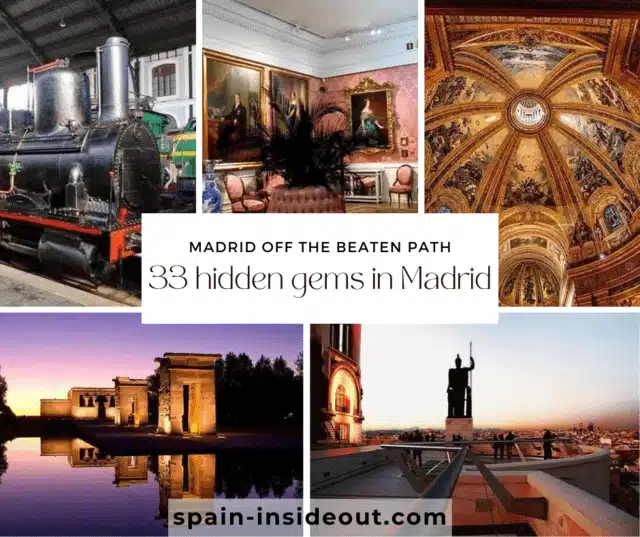
- 3 Amazing Hidden Gems in Madrid That Most Tourists Miss
- Exploring Madrid's Lesser-Known Neighborhoods: Off the Beaten Path
- Madrid's Best Kept Secrets: The Top 5 Hidden Parks and Gardens
- Off the Beaten Path: Hidden Historical Sites in Madrid
- Madrid's Hidden Shopping Treasures: Markets Worth Exploring
- Beyond the Tourist Trail: Secret Spots for Stunning Views of Madrid
- Unveiling the Hidden Cultural Gems of Madrid: Museums Off the Beaten Path
- Madrid off the Beaten Path: Uncover hidden treasures 💎
- FAQs: Secret Spots in Madrid
When you think of Madrid, surely its most emblematic places come to mind: The Royal Palace, the Prado Museum, or Retiro Park. However, beyond the most touristy spots included in all the guidebooks, there is a wealth of hidden gems in Madrid. These treasures will allow you to experience the city in a unique way, off the beaten tourist path.
In this post, I’ll show you lesser-known parks and gardens, charming neighborhoods, and historical sites that are not widely recognized but are wonderful nonetheless. You’ll also discover markets, quirky museums, and secret spots with spectacular views. Nothing more and nothing less than 41 unique places in Madrid that will reveal a more hidden side of the city, yet equally fascinating.
Where are these hidden gems of Madrid? Keep reading, and I’ll tell you everything.
3 Amazing Hidden Gems in Madrid That Most Tourists Miss
The Spain’s capital city is full of hidden gems unknown to visitors. While many of them head to its most popular tourist spots, these lesser-known places will provide you with a much deeper understanding of the city. Here’s a list of several wonderful secrets of Madrid less known to most tourists:
1. Templo de Debod
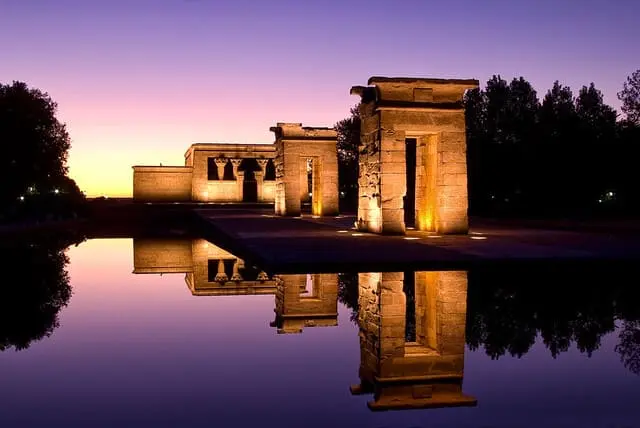
© Photo by Marcos Molina on Flickr // Hidden Gems in Madrid: Templo de Debod
Among Madrid’s many treasures, Templo de Debod stands out Surely you didn’t expect to find an authentic Egyptian monument in this city! The Temple of Debod is an Egyptian temple that was donated to Spain by the Egyptian government as a gesture of gratitude for Spanish assistance in rescuing the temples of Nubia. Located in the Parque del Oeste, this temple offers a stunning view of Madrid and is a very popular spot for watching the sunset and taking photographs.
2. Cripta de la Almudena
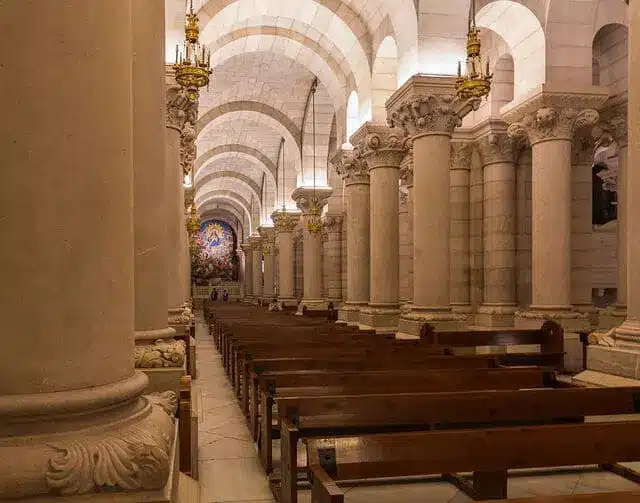
© Photo by Diego Delso on Wikimedia Commons // Hidden Gems in Madrid: Cripta de La Almudena
Although the Almudena Cathedral is one of the most visited places in the city, underneath it lies a hidden corner that often goes unnoticed. This beautiful crypt, supported by four hundred columns, is a treasure hidden beneath the feet of millions of visitors who come to see the Cathedral. Here, you can visit some of its twenty chapels and observe some of the tombs of the more than a thousand people buried here.
3. Monumento a los caídos por España
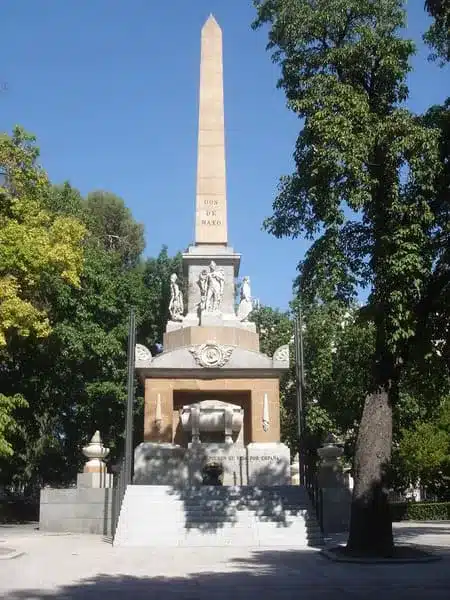
© Photo by Paulo Henrique Rodrigues on Wikimedia Commons // Hidden Gems in Madrid: Monument to the Fallen for Spain
The Monument to the Fallen for Spain, also known as the Monument to the Heroes of May 2nd, was erected in memory of those who died during the May 2nd uprising of 1808, a crucial event in the Spanish War of Independence against French occupation.
The flame burning in the crypt of the Monument to the Fallen for Spain is a symbol of homage and remembrance to those who fell for Spain’s freedom. This perpetual flame represents the sacrifice of those who gave their lives for their country and remains lit as a constant reminder of their bravery.
Exploring Madrid’s Lesser-Known Neighborhoods: Off the Beaten Path
4. Lavapiés
Lavapiés is one of the most diverse neighborhoods in Madrid, known for its multicultural atmosphere and lively street life. Located just steps away from the historic center, Lavapiés has long been a melting pot of cultures and a meeting point for people from diverse backgrounds.
Lavapiés is renowned for its bohemian and alternative vibe, with a unique mix of thrift stores, independent art galleries, traditional bars, and ethnic restaurants that reflect the diversity of its population.
5. La Latina
La Latina is an emblematic neighborhood of Madrid, known for its historic charm and vibrant nightlife. Located west of the city center, this neighborhood has preserved its traditional and authentic character over the years.
One of the standout features of La Latina is its maze of narrow cobblestone streets and picturesque squares. The neighborhood is filled with historic buildings, ancient churches, and colorful facades, all testament to its rich past.
During the day, La Latina comes alive with its bustling street markets. Additionally, the neighborhood is famous for its numerous tapas bars and restaurants, where you can taste delicious Madrid cuisine alongside a glass of wine or beer.
At night, La Latina transforms into one of the city’s most popular nightlife destinations, with a wide variety of bars, taverns, and nightclubs that attract a diverse crowd of residents and visitors. The La Latina neighborhood is a place full of history, culture, and life, where you can discover the authentic essence of Madrid.

6. Malasaña
Malasaña is an alternative and bohemian neighborhoods in Madrid, known for its youthful atmosphere, vibrant cultural scene, and creative spirit. Formerly known as the Barrio de Maravillas, Malasaña has undergone a revitalization in recent decades and is famous for its graffiti-filled streets, vintage shops, art street and charming bars and cafes.
A hallmark of Malasaña is its creative and avant-garde atmosphere, which is reflected in its numerous cultural and creative spaces. Malasaña is also known for its lively nightlife, with a wide range of bars, clubs, and live music venues that keep the festive atmosphere going into the early hours of the morning. From traditional cocktail bars to modern electronic music clubs, there are options for every taste and style.
7. Chamberí
The Chamberí neighborhood is one of the most elegant neighborhoods in Madrid, known for its stately atmosphere, wide tree-lined streets, and classical architecture.
Formerly an independent municipality, Chamberí merged with Madrid in the late 19th century, but it still retains its distinctive identity and its quiet, residential atmosphere. The neighborhood is dotted with elegant neoclassical and modernist buildings, as well as parks and squares that invite you to stroll and relax.
The Chamberí neighborhood is a place full of elegance and charm, where you can enjoy the tranquility and beauty of urban life in a historic and distinguished setting.
8. Huertas
The Barrio de Huertas, also known as the Barrio de las Letras, is one of the most historic and cultural neighborhoods in Madrid, famous for its rich literary heritage. The name “Barrio de las Letras” refers to the golden age of Spanish literature when this neighborhood was home to famous writers like Cervantes, Lope de Vega, and Quevedo. Today, Huertas remains a hub of Madrid’s cultural life, with a wide variety of bookstores, art galleries, theaters, and cafes that keep the literary tradition of the neighborhood alive.
One of the most emblematic areas of Huertas is Calle Huertas itself, a bustling pedestrian street full of tapas bars, restaurants, and taverns where you can enjoy delicious Madrid cuisine. Additionally, the neighborhood is dotted with picturesque squares and historic buildings, such as Plaza de Santa Ana and the Convent of the Trinitarians, which add even more charm to the neighborhood.
Useful links for your trip to Madrid
Public transport tip
If you’re going to use public transport, I recommend using the Moovit app. It includes all public transport options in Madrid (metro, buses, trains) and provides real-time information. If you’re taking the bus, it even shows your location and stops until your destination, so you can rest assured you won’t get lost.
I use it daily to get around Madrid, and it works great!
*This is not an affiliate link. I do not earn any commission.
Madrid’s Best Kept Secrets: The Top 5 Hidden Parks and Gardens
9. Campo del Moro
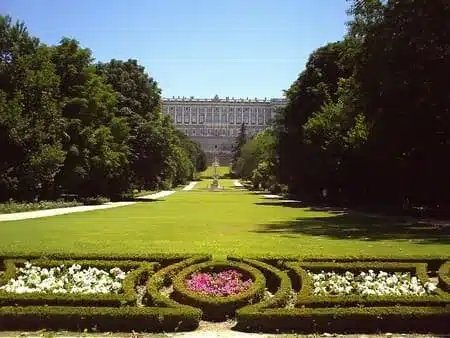
© Photo by s_dd2 on Flickr // Hidden Gems in Madrid: Campo del Moro
The Campo del Moro is a lush and beautiful garden located next to the Royal Palace of Madrid. This magnificent park is one of the most beautiful green spaces in Madrid, offering an oasis of tranquility and beauty amidst the hustle and bustle of the city. Despite the Royal Palace being one of Madrid’s most iconic landmarks, this hidden gem often goes unnoticed by many visitors.
The name “Campo del Moro” dates back to the time of the Reconquista when the area was known as the “Field of the Moors” because it was where the Muslim troops camped during the siege of Madrid.
The Campo del Moro features a wide variety of trees, fountains, ponds, and sculptures that adorn its paths and walkways. From the Campo del Moro, you can enjoy stunning views of the Royal Palace and the Manzanares River, making it an idyllic setting for strolling, relaxing, and enjoying nature.
10. Parque del Capricho
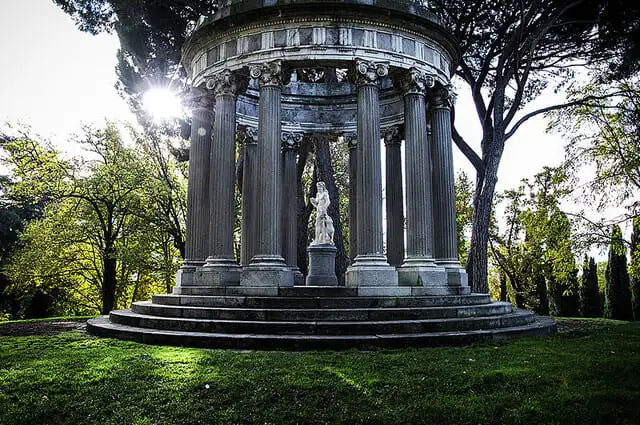
© Photo by JRxpo on Flickr // Hidden Gems in Madrid: Parque del Capricho
The Parque del Capricho is a hidden gem in Madrid, an oasis of tranquility amidst urban life. Situated in the Alameda de Osuna neighborhood, away from the iconic heart of Madrid, it’s one of the city’s best-kept secrets and one of the most beautiful and lesser-known parks in the capital.
Designed in the 18th century by the Duchess of Osuna, a prominent figure in Madrid’s high society at the time, El Capricho was inspired by English and French gardens she had seen during her travels in Europe. The Duchess created a unique space filled with romantic corners, sculptures, ponds, pergolas, and viewpoints that invite visitors to lose themselves and explore its nooks and crannies. The Parque del Capricho is a perfect place to relax and enjoy a peaceful stroll in a charming and unique environment.
11. Parque Juan Carlos I
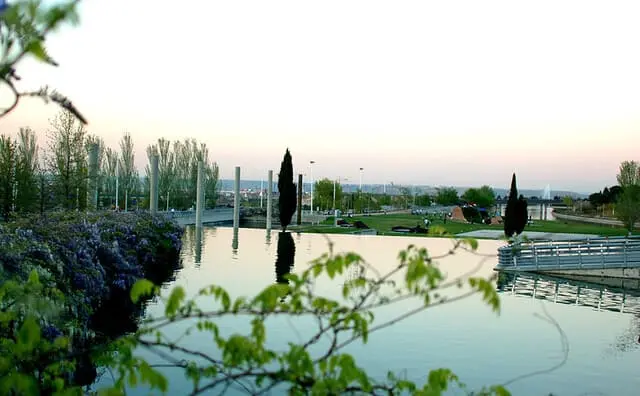
© Photo by Javier Martin Espinosa on Flickr // Hidden Gems in Madrid: Parque Juan Carlos I
The Juan Carlos I Park is one of the largest and most modern parks in Madrid, located in the Hortaleza district in the northeast of the city. This park, inaugurated in 1992, offers a wide variety of activities and attractions for all visitors.
With an area of over 160 hectares, Juan Carlos I Park is an ideal place to enjoy nature and the outdoors. The park features extensive areas of lawn, trees, lakes, and landscaped areas perfect for walking, picnicking, or outdoor sports.
Juan Carlos I Park also offers a wide variety of recreational and sports activities. Visitors can enjoy sports courts, children’s play areas, bike paths, skating rinks, and even a botanical maze.
12. Jardines de Vista Alegre
Los Jardines de Vistalegre son un encantador espacio verde ubicado en el distrito de Carabanchel, uno de los barrios periféricos de Madrid al suroeste de la ciudad. Este parque de aproximadamente 8 hectáreas, ofrece un ambiente tranquilo y relajante donde disfrutar de la naturaleza y el aire libre.
Los Jardines de Vistalegre son conocidos por su diseño paisajístico cuidadosamente planificado, con amplias zonas ajardinadas, senderos arbolados y áreas de descanso. Otra de las características destacadas de los Jardines de Vistalegre es su amplia oferta de instalaciones y actividades recreativas. Los visitantes pueden disfrutar de áreas de juegos infantiles, pistas deportivas, zonas de picnic y espacios para practicar deportes al aire libre como el footing o el ciclismo.
13. Rosaleda del Parque del Oeste
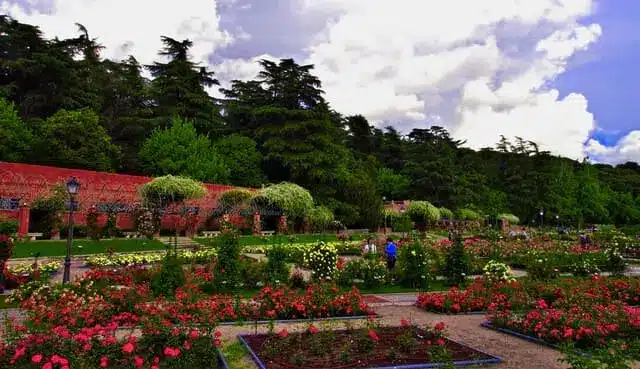
© Photo by Kristijan Arsov on Flickr // The 10 best cities to visit in Spain: Madrid
The Rosaleda of Parque del Oeste is one of the most beautiful spots in Madrid to enjoy the beauty of roses. Located within Parque del Oeste, this rose garden is a hidden gem for both local residents and tourists visiting the city.
This charming garden boasts an extensive collection of roses of different varieties and colors, which bloom during the spring and summer, creating a stunning visual display. The rosaleda is carefully designed and maintained, offering a tranquil and serene environment for strolling. From its pathways, visitors can enjoy panoramic views of Parque del Oeste and its surroundings, making it a perfect place to relax and enjoy nature amidst the city.
The Rosaleda of Parque del Oeste is also known for its famous international rose competition, held annually, which attracts gardening experts and rose lovers from around the world. During the competition, the best rose varieties are awarded in different categories, adding even more prestige to this beautiful garden.
Off the Beaten Path: Hidden Historical Sites in Madrid
14. Ermita de San Antonio de la Florida
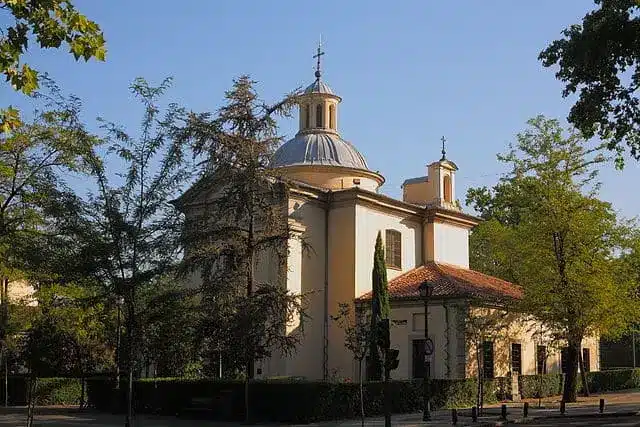
© Photo by Sanva1959 on Wikimedia Commons // Hidden Gems in Madrid: Ermita de San Antonio de la Florida
The Hermitage of San Antonio de la Florida is a late 18th-century religious building located in the Moncloa-Aravaca district. This hermitage follows the typical neoclassical style of the time and is a pilgrimage site for devotees of Saint Anthony of Padua.
However, the most impressive aspect of this place is the frescoes painted by Francisco de Goya between 1798 and 1799. These masterpieces depict scenes from the life of Saint Anthony of Padua and extend across the walls and dome of the hermitage, creating an impressive work of art and one of Madrid’s greatest hidden treasures.
15. Basílica de San Francisco el Grande
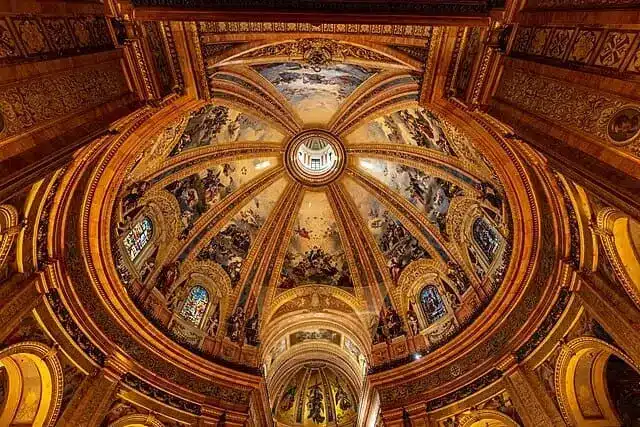
© Photo by KDiego Dolso on Wikimedia Commons // Hidden Gems in Madrid: Basílica de San Francisco el Grande
The Basilica of San Francisco el Grande is a majestic religious building located in the La Latina neighborhood. This basilica is one of the most spectacular temples in the city and a hidden gem in the heart of Madrid, often overlooked by traditional tourist routes.
Construction of the basilica began in the 18th century and was not completed until the 19th century. The predominant architectural style is neoclassical, although it also features baroque and rococo influences.
The exterior of the Basilica of San Francisco el Grande is impressive, with a towering dome that rises above the Madrid skyline and is visible from various points in the city. The interior of the basilica is equally impressive, with a spacious and luminous central nave leading to the main altar. The altar is adorned with a magnificent fresco painting of the Assumption of the Virgin, executed by Goya.
16. Estación de Chamberí
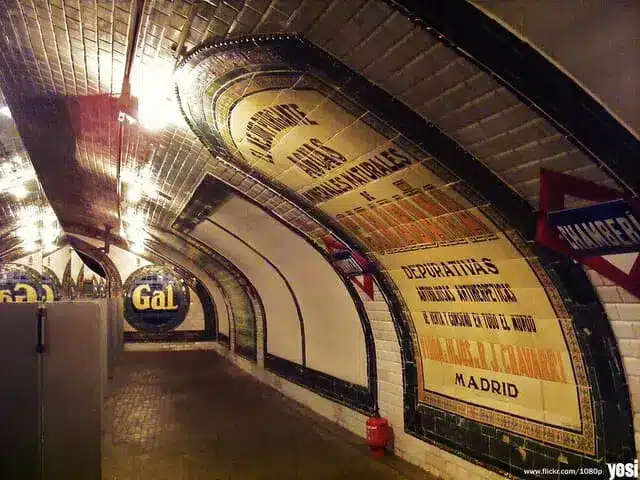
© Photo by Andres Moreno on Flickr // Hidden Gems in Madrid: Chamberí Station
The Chamberí metro station was inaugurated in 1919 as part of the city’s first metro line, the current Line 1.
The most curious aspect of Chamberí station is that it ceased operations in 1966 due to the modernization of the metro network, turning it into a ghost station for decades. However, instead of being demolished, it was decided to preserve its structure and convert it into a museum and cultural space.
Today, Chamberí metro station is a museum showcasing how metro stations in Madrid looked in the past. Visitors can walk along the platforms and see the old advertisements, posters, and tiles that adorned the station in the 1920s, as if the station were a window to the past that had been frozen in time. There are also exhibitions explaining the history of the Madrid metro.
17. Hospital de Maudes
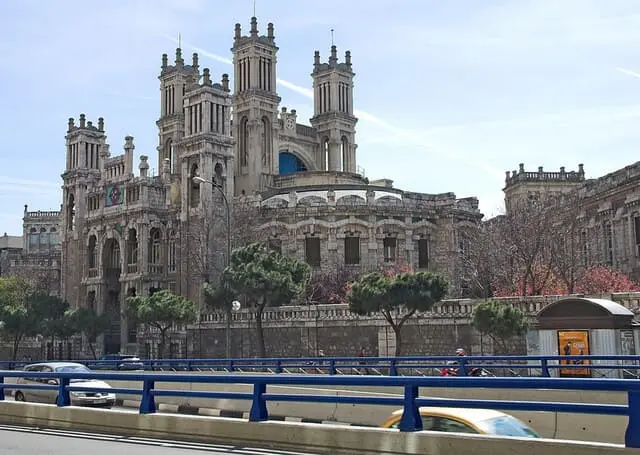
© Photo by Ramon Durán on Flickr // Hidden Gems in Madrid: Hospital de Maudes
The Palacio de Maudes, originally the Hospital of San Francisco de Paula for Day Laborers, was inaugurated in 1916. The construction of this imposing palace-like building, which occupies an entire city block, was promoted to house a hospital to attend to workers who did not have sufficient economic means.
During the Civil War and the postwar period, the hospital was used for military purposes, but from 1964 and for two decades it fell into complete abandonment until it was acquired by the Community of Madrid and underwent a major renovation.
Currently, it houses the headquarters of the Department of Transport, Housing, and Infrastructure.
18. Palacio Fernán Núñez
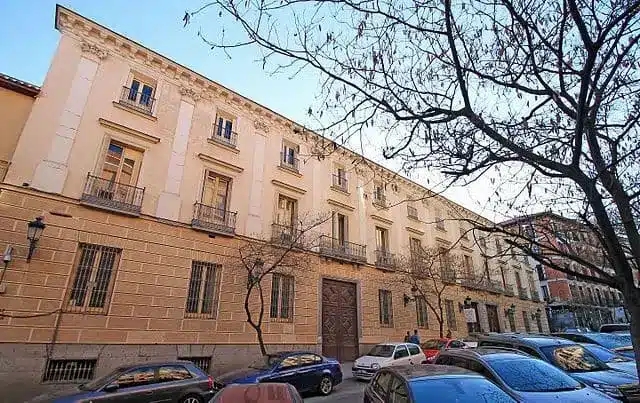
© Photo by Luis García on Flickr // Hidden Gems in Madrid: Palacio de Fernan Nuñez
The Fernán Núñez Palace is a magnificent palatial residence located near Atocha. Built between 1847 and 1849 as the family residence of the Duke of Fernán Núñez, this palace is an example of the opulence and refinement of Spanish nobility in the 19th century.
Currently, it houses the headquarters of the Spanish Railways Foundation, which offers guided tours lasting an hour and a half through the rooms and halls. It is not possible to visit independently.
Madrid’s Hidden Shopping Treasures: Markets Worth Exploring
19. Mercado de San Ildefonso
The Mercado de San Ildefonso is a popular gastronomic space located in the heart of Madrid, on the bustling Fuencarral street.
Opened in 2014, the Mercado de San Ildefonso occupies a historic three-story building that has been restored and transformed into a meeting place for food and drink enthusiasts. The market houses a wide variety of food and beverage stalls, offering everything from traditional Spanish tapas to international dishes and gourmet specialties.
With its spacious outdoor terraces, seating areas, and music, the market is the perfect place to enjoy a casual meal with friends or family and has become a reference point in Madrid’s gastronomic scene.
20. Mercado de Productores
El Mercado de Productores de Madrid es una iniciativa que busca promover y apoyar la agricultura local y sostenible, así como acercar a los consumidores a los productores de alimentos frescos y de calidad. Este mercado se celebra durante las mañanas del primer y tercer domingo de cada mes y ofrece una amplia variedad de productos frescos, artesanales y de temporada directamente de los agricultores y productores locales.
El mercado es un lugar donde los agricultores, ganaderos, pescadores y artesanos pueden mostrar y vender sus productos directamente al público, eliminando intermediarios y garantizando precios justos tanto para los productores como para los consumidores. Los visitantes del mercado pueden encontrar una amplia gama de productos frescos, como frutas y verduras, carne, pescado, lácteos, pan y repostería, así como productos artesanales como quesos, embutidos, miel, aceites y conservas.
Además de la venta de productos, el Mercado de Productores de Madrid también ofrece actividades y eventos relacionados con la agricultura, la gastronomía y la sostenibilidad, como degustaciones, talleres, charlas y demostraciones culinarias. Estos eventos ayudan a promover la educación alimentaria y concienciar sobre la importancia de apoyar la producción local y sostenible.
21. Mercado de Diseño
The Madrid Design Market is a recurring event that brings together designers, creators, and artisans to showcase and sell their original, high-quality products. This market is regularly held in different locations throughout the city, providing a platform for both emerging and established designers to exhibit their unique creations in fashion, decor, art, jewelry, and much more.
The Design Market stands out for its focus on contemporary design and creativity, offering visitors the opportunity to discover unique and original pieces not found in conventional stores. Exhibitors are typically carefully selected to ensure the quality and diversity of the products offered.
In addition to product sales, the Madrid Design Market also offers a variety of activities and entertainment, such as creative workshops, talks with designers, live music, and gastronomic options.
22. Mercado de la Paz
The Mercado de la Paz is one of Madrid’s most emblematic markets, located in the Salamanca neighborhood, known for its elegant and distinguished atmosphere. This traditional market, inaugurated in 1882, offers a wide variety of fresh and gourmet products and stands out for its high-quality fresh produce, including fruits, vegetables, meats, fish, and seafood, as well as cheeses, cold cuts, olives, and artisan breads. Additionally, it features a selection of stalls offering prepared food where visitors can enjoy traditional dishes and international delicacies.
23. Mercado de San Antón
The Mercado de San Antón is a popular culinary destination located in the Chueca neighborhood in the heart of Madrid. Inaugurated in 2011, this market has become a reference point for gastronomy enthusiasts.
The market has three floors housing a variety of stalls offering fresh food, gourmet products, specialized shops, and restaurants. On the ground floor, visitors can find a wide selection of fresh products such as fruits, vegetables, meats, fish, and seafood. On the upper floors, there are a variety of options to enjoy a meal or a drink, from tapas bars and casual restaurants to terraces with panoramic views of the city.
Beyond the Tourist Trail: Secret Spots for Stunning Views of Madrid
24. Parque del Cerro del Tío Pío
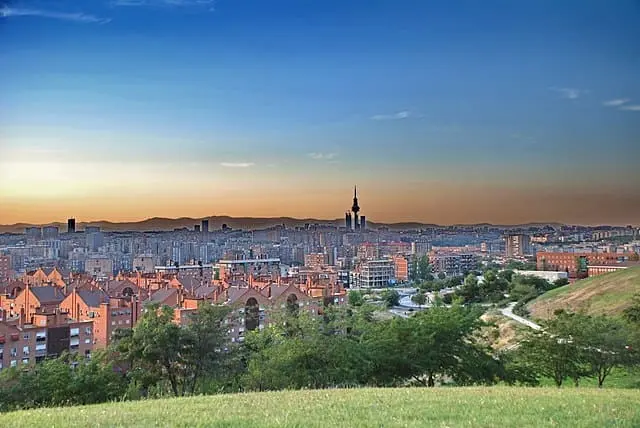
© Photo by frankblacknoir on Wikimedia Commons // Hidden Gems in Madrid: Parque del Cerro del Tío Pío
The Parque del Cerro del Tío Pío, also known as the Park of the Seven Hills due to its characteristic hills, is an emblematic spot in Madrid to enjoy panoramic views of the city. Located in the Vallecas district, a peripheral neighborhood in the southeast of Madrid, this park offers stunning views of the city skyline.
The park features several landscaped areas, walking trails, and resting areas, making it an ideal spot to relax and enjoy the outdoors. From the hilltops, panoramic views of Madrid can be admired. It’s an ideal destination to enjoy spectacular sunsets and to observe the city lights at dusk.
25. Terraza del Círculo de Bellas Artes
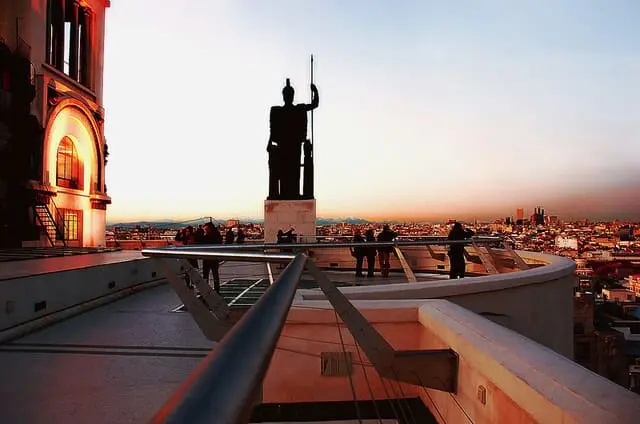
© Photo by Javier Martin Espartosa on Flickr // Hidden Gems in Madrid: Terrace of the Círculo de Bellas Artes
The Terrace of the Círculo de Bellas Artes is another fantastic spot in Madrid to enjoy panoramic views of the city. Located on the rooftop of the Círculo de Bellas Artes, a historic building in the heart of Madrid, this terrace offers an impressive view of the city skyline and some of its most emblematic landmarks.
In addition to the breathtaking views, the Terrace of the Círculo de Bellas Artes is known for its lively and cosmopolitan atmosphere. During the day, it’s a perfect place to relax and soak up the sun while admiring the city from above. At night, it transforms into a vibrant meeting point where you can enjoy cocktails and music.
26. Faro de Moncloa
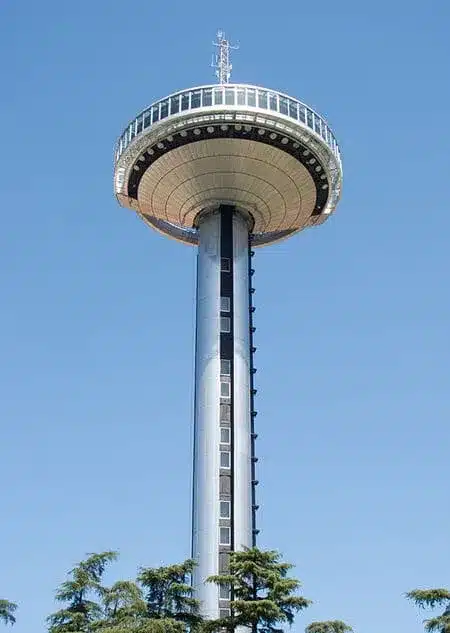
© Photo by Carlos Delgado on Wikimedia Commons // Hidden Gems in Madrid: Faro de Moncloa
Ascend to new heights at Faro de Moncloa, a hidden observation tower offering 360-degree views of Madrid. Located in the Moncloa-Aravaca district, this iconic landmark provides visitors with a bird’s eye perspective of the city’s landmarks, including the Royal Palace, Plaza de España, and Gran Vía. Climb to the top, snap some photos, and marvel at the breathtaking vistas stretching out before you.
27. Terraza del Hotel Riu Plaza España (Sky Bar 360)
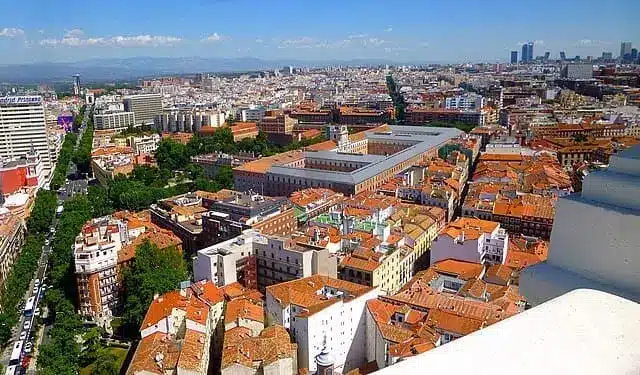
© Photo by Zarateman on Wikimedia Commons // Hidden Gems in Madrid: Sky Bar 360
The 360º Rooftop Bar is a stunning hidden gem located on the rooftop of the Hotel Riu Plaza España in a prime location in the heart of Madrid. It offers panoramic 360-degree views of the city, including some of its most iconic landmarks such as the Royal Palace, the Almudena Cathedral, and Gran Vía.
This rooftop bar is known for its elegant and modern atmosphere, perfect for enjoying cocktails and drinks while taking in the breathtaking urban landscape of Madrid. In addition to drinks, it also offers a selection of snacks and tapas to complement the experience.
The 360º Rooftop Bar is especially recommended at sunset when visitors can enjoy the spectacular sunset over the city. It’s a perfect place to unwind or enjoy a unique night out in the Spanish capital.
Unveiling the Hidden Cultural Gems of Madrid: Museums Off the Beaten Path
28. Museo Sorolla
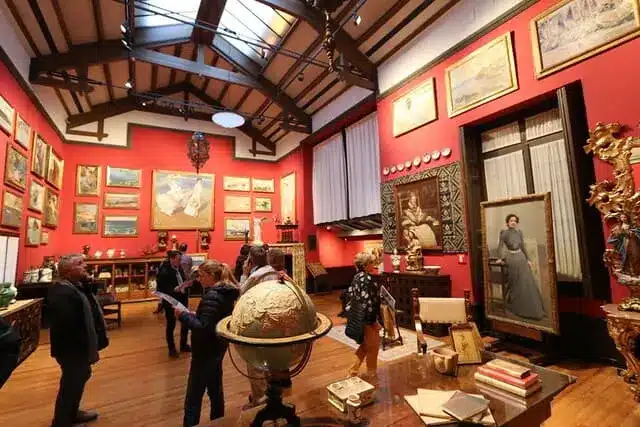
© Photo by Juan Antonio Segal on Flickr // Hidden Gems in Madrid: Museo Sorolla
The Sorolla Museum is a true cultural hidden gem in Madrid, located in the former residence of the painter Joaquín Sorolla. This museum offers an intimate look into the life and work of one of the most prominent painters of Spanish art from the 19th and early 20th centuries.
The building itself is an architectural masterpiece and reflects Sorolla’s own taste for the architecture of his time. The museum houses a vast collection of the artist’s works, including paintings, sculptures, drawings, and personal objects, providing a comprehensive view of his career and artistic evolution.
Additionally, the museum features a beautiful garden that reflects the painter’s love for nature and serves as an oasis of tranquility in the city’s hustle and bustle.
The Sorolla Museum is a must-visit for art lovers and offers a unique experience for those who wish to learn more about the life and work of this renowned Spanish painter.
29. Museo del Traje
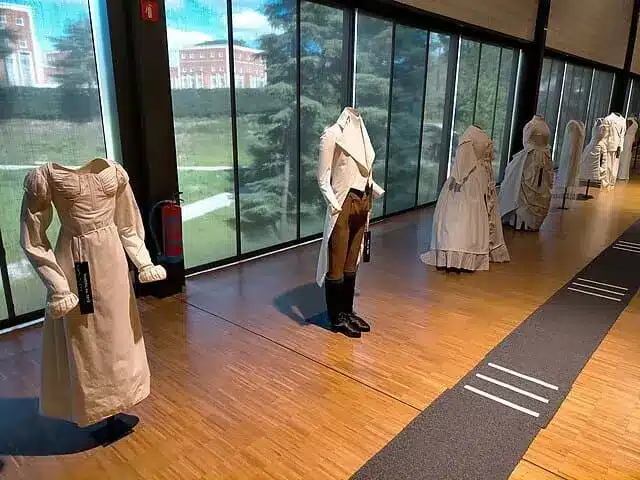
© Photo by Emilio J. Rodríguez Posada on Wikimedia Commons // Hidden Gems in Madrid: Museo del Traje
The Museum of Costume in Madrid is a place dedicated to the history of clothing and fashion in Spain. The museum houses an extensive collection of garments and accessories spanning from the Middle Ages to the present day.
The Museum of Costume offers a fascinating insight into the evolution of Spanish fashion throughout the centuries. Exhibits include historical costumes, period dresses, military uniforms, regional attire, and contemporary designs by prominent Spanish designers.
In addition to the permanent exhibitions, the Museum of Costume hosts temporary exhibits, lectures, workshops, and educational activities related to fashion and attire. It also features a specialized library on the history of costume and fashion, which is open to the public for research and consultation.
30. Museo del Romanticismo
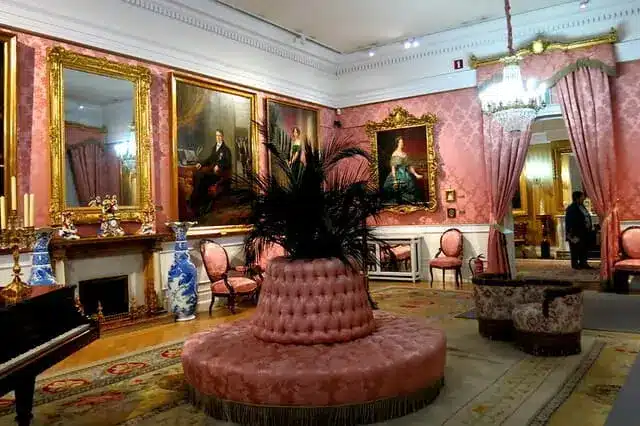
© Photo by Manuel MV on Flickr // Hidden Gems in Madrid: Museo del Romanticismo
The Museum of Romanticism in Madrid is a place that transports its visitors to the Romantic period in Spain, offering an intimate glimpse into life during this historical era. Located in an old 18th-century palace, the museum houses a rich collection of art, furniture, books, and other objects from everyday life during the Romantic era.
The museum showcases what life was like in Spanish society in the 19th century, highlighting aspects such as fashion, literature, music, and reflecting the lifestyle of the bourgeoisie and aristocracy of the period.
It’s a fascinating place for those interested in immersing themselves in the history and culture of the 19th century in Spain.
31. Museo Geominero
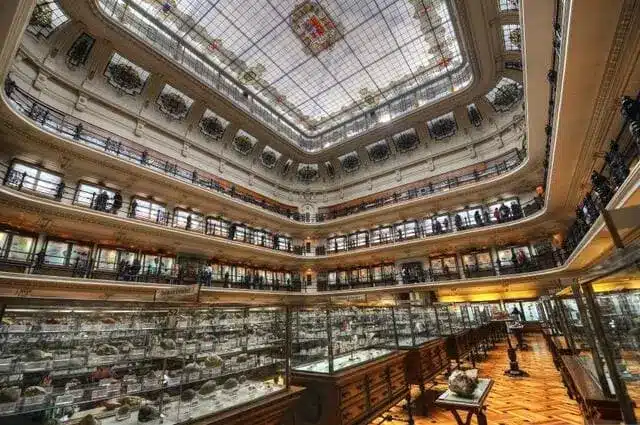
© Photo by Jose Maria Cuellar on Flickr // Hidden Gems in Madrid: Museo Geominero
The Geominero Museum of Madrid is a center dedicated to geology and mining, with its main objective being the dissemination and education in the field of Earth sciences.
The museum houses an extensive collection of minerals, rocks, fossils, and other elements related to geology, showcasing the geological richness of Spain and other parts of the world. Additionally, it features permanent exhibitions covering topics such as Earth’s formation, the geology of Spain, mining, and the exploitation of natural resources, among others.
The Geominero Museum also organizes educational activities, conferences, workshops, and temporary exhibitions to bring geological science to the general public and promote interest in this subject.
32. Museo de Historia de Madrid
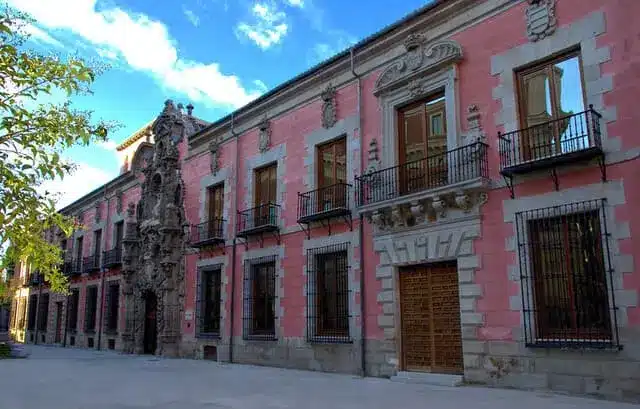
© Photo by Javier Martin Espartosa on Flickr // Hidden Gems in Madrid: Museo de Historia de Madrid
The Museum of Madrid History is a space dedicated to preserving and exhibiting the history of the city of Madrid. This museum offers a comprehensive tour through Madrid’s history, from its prehistoric origins to the present day.
The museum houses a wide variety of artifacts, documents, photographs, and other objects that illustrate Madrid’s evolution over the centuries. From archaeological objects depicting daily life in ancient times to paintings and sculptures reflecting key moments in Madrid’s history.
33. Museo del Ferrocarril

© Photo by Jose Luis RDS on Flickr // Hidden Gems in Madrid: Museo del Ferrocarril
The Railway Museum of Madrid is a fascinating place that offers a unique look into the history and development of the railway in Spain. Located in the former Delicias station, this museum houses an impressive collection of locomotives, carriages, models, and other objects related to the railway.
The museum showcases the technological evolution of railway transport from its beginnings to the present day, highlighting the importance of the railway in the economic and social development of the country. Visitors can explore different thematic rooms that address aspects such as the construction of railway tracks, train operation, and the daily life of railway workers.
Madrid off the Beaten Path: Uncover hidden treasures 💎
Madrid is a city full of surprises and hidden treasures beyond the most iconic and crowded tourist spots. Some of them are even little known to residents! From ancient temples and historic sites to unique neighborhoods full of personality, all these options will allow you to discover the city in a deeper way and get to know Madrid off the beaten path.
I encourage you to explore Madrid’s hidden gems beyond the tourist circuit and let yourself be amazed by these secret spots of Madrid. Pack your bags, put on your walking shoes, and discover the magic of Madrid off the beaten path! Happy travels y hasta pronto! 🤗
FAQs: Secret Spots in Madrid
What are some hidden gems with views of Madrid’s skyline?
In Madrid, you can find several places that offer impressive views of the Madrid skyline. One of these hidden gems in the heart of Madrid is the rooftop terrace at the Circulo de Bellas Artes, where you can enjoy one of the best panoramic views of the city. Another alternative is the 360º Rooftop Bar, which allows you to experience Madrid from a different perspective.
Where can I find the best Madrid hidden gems?
To discover the best Madrid hidden gems, venture off the typical tourist path and explore neighborhoods like Lavapiés, Huertas, La Latina, and Malasaña. These areas of the center of Madrid are filled with hidden places and corners steeped in history, allowing you to uncover the essence of the city.
What are some unique historical sites in Madrid off the beaten path?
Madrid is full of unique historical sites that are often overlooked by tourists. When exploring Madrid, there are many hidden gems and secret spots off the beaten path, and two notable ones include the Basilica of San Francisco el Grande and the Fernán Núñez Palace.
The Basilica of San Francisco el Grande is a stunning church featuring magnificent artwork and architecture, including works by renowned artists like Goya.
Another hidden gem is the Fernán Núñez Palace, a majestic building with rich history and exquisite design, offering visitors a glimpse into Madrid’s aristocratic past.
These sites are among the best hidden gems in Madrid, providing a unique and enriching experience for those who seek to uncover the city’s lesser-known treasures.
Are there any lesser-known museums in Madrid worth visiting?
When you visit Madrid, there are several lesser-known museums worth exploring beyond the popular attractions. Two of these hidden gems in Madrid are the Sorolla Museum and the Museum of Madrid History.
The Sorolla Museum showcases the works of the Spanish painter Joaquín Sorolla in his former residence, offering a tour of his life and artistic legacy. It’s a hidden gem for art lovers seeking unique activities to do in Madrid.
On the other hand, the Museum of Madrid History provides a glimpse into the city’s past, displaying artifacts and exhibitions that will allow you to understand the historical heritage of the capital of Spain.
Both museums offer an alternative experience for those looking to make the most of their time in Madrid by discovering its lesser-known attractions.

My name is Belén, and I’m the one behind this blog. I was born and raised in the wonderful city of Barcelona, but since my family is from Galicia, I moved to this beautiful land in the northwest of Spain when I was thirteen. I lived there until I finished University and decided to make a living in the capital, Madrid. And here is where I currently live and work.
When I travel, I usually avoid organized tours and prefer to research my destination and establish my own route. That’s why I came up with the idea of writing a travel blog. But a travel blog, in reverse! From the perspective of someone who knows the country and welcomes visitors from other places.
If you love Spain and want to learn more about this wonderful country, welcome to SpainInsideout.com!